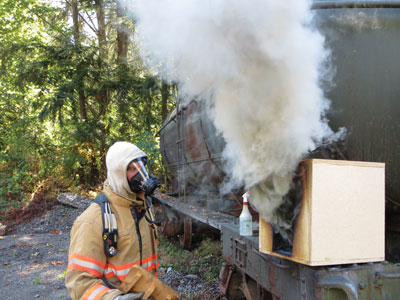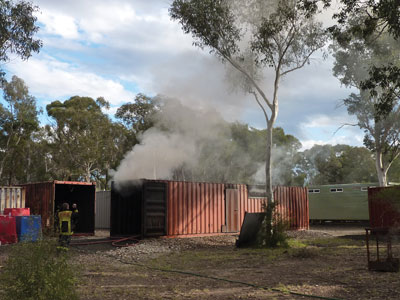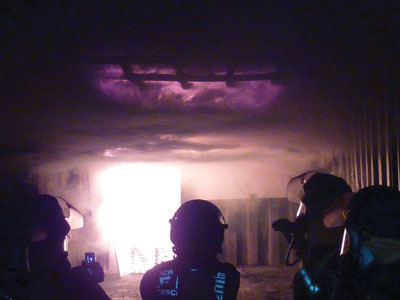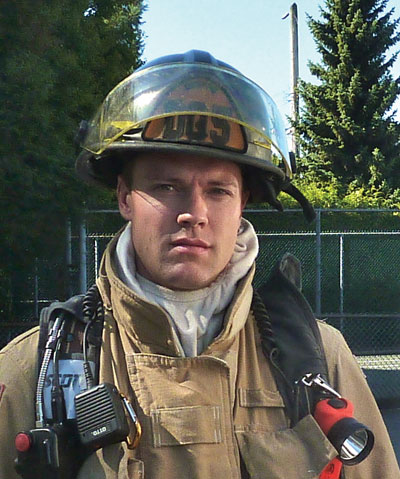
Features
Structural
Training
Science-backed Training
Sweden could be seen by North American firefighters as a somewhat strange country
November 1, 2012
By Ian Bolton
Sweden could be seen by North American firefighters as a somewhat strange country: University is free; the average worker gets a minimum of five weeks of paid vacation a year; and firefighters are rarely killed in the line of duty.
 |
|
| Fire instructors use a small-scale prop to demonstrate to firefighters various types of fire-behaviour events, in this case creating a backdraft. Photos by Ian Bolton |
“Fire fighting isn’t even seen as a dangerous job here,” explains Swedish firefighter Erik Elvermark. In fact, Sweden hasn’t lost a single firefighter due to fire progress in more than 30 years. However, this incredible safety record is the legacy of tragedy: In the late 1970s and early ’80s the Stockholm Fire Brigade lost numerous firefighters to extreme fire behaviour events.
In reaction to those deaths, the works of two Swedish fire engineers, Mats Rosander and Krister Giselsson, were finally implemented as part of a new national firefighter-training program. Before the fatal incidents, Rosander and Giselsson’s in-depth research of extreme fire behaviour and the deadly nature of fire gases was considered radical and unwarranted; after the incidents, it was viewed as the solution to firefighter deaths.
It was through the implementation of a new firefighter-training program in Sweden that Compartment Fire Behaviour Training (CFBT) was born. Not only had Rosander and Giselsson been studying fire behaviour to a level never before witnessed, but they had also developed groundbreaking techniques to allow firefighters inside a burning structure to take control of the fire gases and the fire environment itself.
One unique aspect of the Swedish fire service is that it employs fire engineers to work directly in the fire service to do research and develop strategies, tactics and training for firefighters.
“In Sweden, we do what we have to do to save lives,” says Dr. Stefan Svensson, a fire captain who has a PhD in fire engineering. “But we try to do it safely, with science and thought behind it. We want [the firefighters] to understand the dynamics, the physics, the chemistry [of fires] and to handle situations based on that knowledge.”
The results of this training have been astounding: The Swedish fire service has reduced the number of firefighters killed from extreme fire behaviour to zero from three deaths every two years since the inception of these programs in the early 1980s.
WHAT IS CFBT?
One of the first fire departments in North America to introduce CFBT was Gresham Fire Rescue in Oregon under the direction of then Battalion Chief Ed Hartin after he trained and studied in Sweden in 2002. Now, the fire chief of Whidbey Island Fire in Washington, and widely considered internationally as a leading expert, Hartin describes CFBT as:
. . integrating the topics of fire behavior, fire streams and ventilation within a structural firefighting context. This training concept provides an integrated framework for developing structural firefighting knowledge and skills. The difference between live fire training in general and CFBT is the emphasis on developing an understanding of fire behavior and the influence of tactical operations. In many cases, live fire training focuses, to a greater extent, on the tactics involved and less on fire behavior. While tactical proficiency is important, understanding fire behavior and recognition of fire development and key fire behavior indicators is critical to firefighter safety and survival.
Large and expensive burn buildings are not needed for these programs. In fact, a modified ISO shipping container is preferred for the live fire sessions. With relatively minor modifications, these burn cells can be turned into a firefighter’s laboratory. Instructors are then able to create the exact conditions required for fire behaviour demonstrations, along with interior control and attack practice.
“While often referred to as flashover training, CFBT involves much more than simply learning to recognize and react to impending flashover conditions,” says Hartin. “A firefighter’s safety is dependent on early recognition of the indicators of a range of extreme fire behaviour.”
Imparting in-depth knowledge to firefighters by bringing the science to the street is the ultimate goal of any CFBT program. Through classroom lectures, videos and studies, small-scale fire behaviour props and carefully controlled live fire training, firefighters are given the knowledge and skills needed to keep them safe on an increasingly dangerous fire ground. CFBT teaches firefighters not just how, but why.
The global movement and impact
Unfortunately, over the last 15 years, CFBT programs have been developed only in reaction to tragic firefighter deaths.
 |
|
| Large and expensive burn buildings are not needed for compartment fire behaviour training programs; a modified shipping container is preferred for the live fire sessions. With minor modifications, these burn cells can be turned into a firefighter’s laboratory. Instructors are then able to create the exact conditions required for fire behaviour demonstrations, along with interior control and attack practice. |
During the 1990s, the United Kingdom was losing an extremely high number of firefighters on the fire ground. However, it wasn’t until early 1996, after losing three firefighters in three days, that the fire service responded with a plan to correct this frightening trend. The plan specifically entailed the development and implementation of CFBT programs throughout the country. The impact was staggering. The United Kingdom Fire Brigades Union report on firefighter fatalities from 1990 leading up to those three tragic deaths shows that 13 firefighters died on the fire ground during that period. However, during the seven-year period following the introduction of CFBT programs throughout the United Kingdom, the number of firefighter fatalities on the fire ground dropped to two.
“It’s made the job of fire fighting far safer, in my opinion, and I think in everybody’s opinion in the U.K.,” says Tam Alford, training division manager at Devon & Somerset Fire Rescue in England. “We are now proactive with fire, rather than reacting to what fire does.”
Countries around the world from Argentina to Russia have responded to firefighter tragedies by developing their own CFBT programs. Australia implemented its first CFBT program in 1997 following the deaths of two firefighters in Queensland due to flashover. Programs spread across the country to each state fire service, but in most cases only after incurring their own losses or close calls. New South Wales is now leading the way with its program following the training in Sweden of Inspector John McDonough, team leader of fire training, in 2003.
“What I liked about the Swedish system was that the firefighters were now in control,” McDonough says. “When we started training back home in Australia, the first thing that many firefighters would say, even very experienced firefighters, was that for the first time in their career they felt like they were in control because they understood what was happening around them.”
Australia has not lost a firefighter on the fire ground since the introduction of its CFBT program.
Canada and CFBT
In Canada, it was recommended that Ottawa Fire Services (OFS) begin CFBT training after the Forward Avenue fire on Feb. 12, 2007, during which five members were forced to jump out of a fourth-floor window to escape rapid fire progress. The official report that followed urged “OFS instructors [to] undertake Level I and Level II Compartment Fire Behaviour Training in order to deliver it within the department.”

|
|
| Imparting in-depth knowledge to firefighters by bringing the science to the street is the ultimate goal of any CFBT program.
|
In western Canada, the District of North Vancouver Fire Rescue was the first in the country to initiate CFBT proactively. The response from firefighters has been very positive.
“It is the best fire training I’ve had in my 18 years on the job,” says Capt. Kit Little. “I can really see this taking us in the direction we need to go in terms of safety and knowledge.”
The program is being developed in a multi-stage strategy, with advancements planned over the next three years, which include a T-burn cell and tactical ventilation instruction.
“The biggest advantages we see with implementing a CFBT program are being able to provide a very high level of fire behaviour knowledge and live fire training to our firefighters in a safe and cost effective way,” says Curtis Bremner, assistant fire chief of training and development.
Is the Canadian fire service looking in the right direction?
Fire-service leaders and trainers seem to agree that we need to increase safety on the fire ground. But have we been focusing on the right things? Rapid intervention teams are an important part of our safety, but are not the only answer. The unfortunate truth is that there is nothing the most highly trained and prepared RIT could do to help a crew caught in flashover. Those crew members will have only seconds before their bodies shut down due to extreme thermal impact.
Some departments are going even further in efforts to help members get out of trouble by teaching radical new techniques. Firefighters are being taught to bail out of upper floor windows head first down ladders, or to rappel from harnesses placed over their turnout gear. Is this where we should be directing our efforts? Or does it make more sense to teach firefighters how to avoid life-threatening situations in the first place?
The North American firefighter fatality rate (per fire) is going up, not down. Today’s structural firefighting operations and the fire environments in which we operate are more dangerous than ever before due to lightweight construction and synthetic-based furnishings. Rooms that once took upwards of 30 minutes to reach flashover, can now flash over in fewer than four minutes. Our working environment has changed drastically, and so must our tactics, training, knowledge and understanding. If we fail as a Canadian fire service to update our methods, and adapt to this new working environment, we will inevitably continue to face tragic losses of our brothers and sisters that need not happen.
 |
|
Ian Bolton has been active in the Fire Service for 10 years. While working in Australia he achieved Instructor level certification in compartment fire behaviour training (cfbt) and tactical ventilation, and has received advanced training in fire behaviour and ventilation from the Swedish Civil Contingencies Agency in Revinge, Sweden. Ian is currently working as a firefighter and lead fire behaviour instructor for the District of North Vancouver Fire and Rescue Service. He is also studying fire dynamics in preparation for exams with Institute of Fire Engineers. Contact Ian at ian.bolton@firedynamics.ca
Print this page